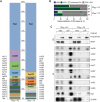ProQ-associated small RNAs control motility in Vibrio cholerae
- PMID: 39727155
- PMCID: PMC11879080
- DOI: 10.1093/nar/gkae1283
ProQ-associated small RNAs control motility in Vibrio cholerae
Abstract
Gene regulation at the post-transcriptional level is prevalent in all domains of life. In bacteria, ProQ-like proteins have emerged as important RNA chaperones facilitating RNA stability and RNA duplex formation. In the major human pathogen Vibrio cholerae, post-transcriptional gene regulation is key for virulence, biofilm formation, and antibiotic resistance, yet the role of ProQ has not been studied. Here, we show that ProQ interacts with hundreds of transcripts in V. cholerae, including the highly abundant FlaX small RNA (sRNA). Global analyses of RNA duplex formation using RIL-Seq (RNA interaction by ligation and sequencing) revealed a vast network of ProQ-assisted interactions and identified a role for FlaX in motility regulation. Specifically, FlaX base-pairs with multiple sites on the flaB flagellin mRNA, preventing 30S ribosome binding and translation initiation. V. cholerae cells lacking flaX display impaired motility gene expression, altered flagella composition and reduced swimming in liquid environments. Our results provide a global view on ProQ-associated RNA duplex formation and pinpoint the mechanistic and phenotypic consequences associated with ProQ-associated sRNAs in V. cholerae.
© The Author(s) 2024. Published by Oxford University Press on behalf of Nucleic Acids Research.
Figures









Similar articles
-
Modulation of Vibrio cholerae gene expression through conjugative delivery of engineered regulatory small RNAs.J Bacteriol. 2024 Oct 24;206(10):e0014224. doi: 10.1128/jb.00142-24. Epub 2024 Sep 18. J Bacteriol. 2024. PMID: 39292012 Free PMC article.
-
Interplay of two small RNAs fine-tunes hierarchical flagella gene expression in Campylobacter jejuni.Nat Commun. 2024 Jun 19;15(1):5240. doi: 10.1038/s41467-024-48986-8. Nat Commun. 2024. PMID: 38897989 Free PMC article.
-
RNA-binding activity and regulatory functions of the emerging sRNA-binding protein ProQ.Biochim Biophys Acta Gene Regul Mech. 2020 Sep;1863(9):194596. doi: 10.1016/j.bbagrm.2020.194596. Epub 2020 Jun 19. Biochim Biophys Acta Gene Regul Mech. 2020. PMID: 32565402 Review.
-
A Critical Region in the FlaA Flagellin Facilitates Filament Formation of the Vibrio cholerae Flagellum.J Bacteriol. 2018 Jul 10;200(15):e00029-18. doi: 10.1128/JB.00029-18. Print 2018 Aug 1. J Bacteriol. 2018. PMID: 29581407 Free PMC article.
-
Biological Insights from RNA-RNA Interactomes in Bacteria, as Revealed by RIL-seq.Methods Mol Biol. 2025;2866:189-206. doi: 10.1007/978-1-0716-4192-7_11. Methods Mol Biol. 2025. PMID: 39546204 Review.
Cited by
-
Unexpected Richness of the Bacterial Small RNA World.J Mol Biol. 2025 Jun 1;437(11):169045. doi: 10.1016/j.jmb.2025.169045. Epub 2025 Feb 25. J Mol Biol. 2025. PMID: 40015371 Review.
References
-
- Kanungo S., Azman A.S., Ramamurthy T., Deen J., Dutta S.. Cholera. Lancet. 2022; 399:1429–1440. - PubMed
MeSH terms
Substances
Grants and funding
LinkOut - more resources
Full Text Sources
Molecular Biology Databases

